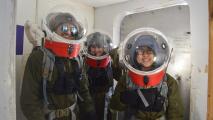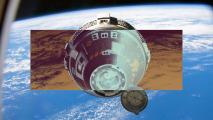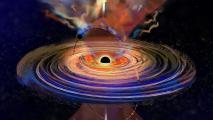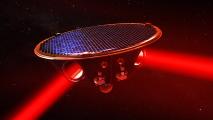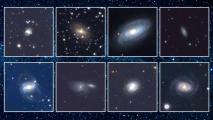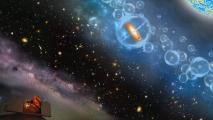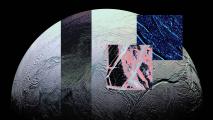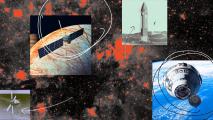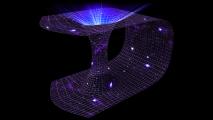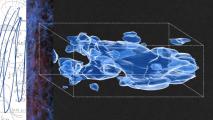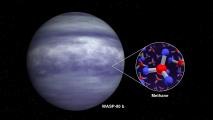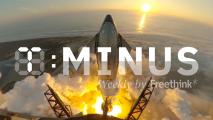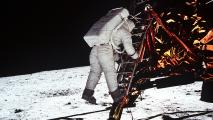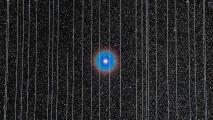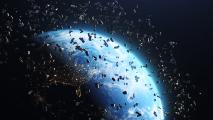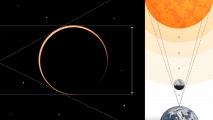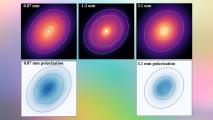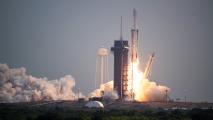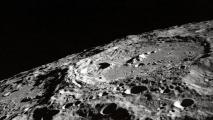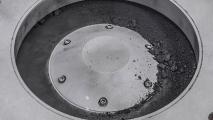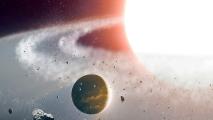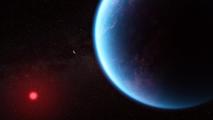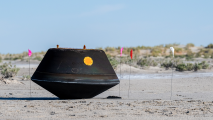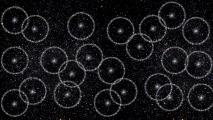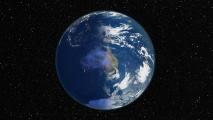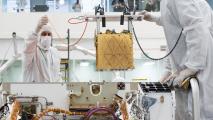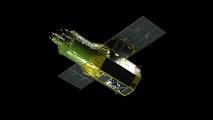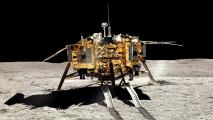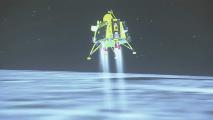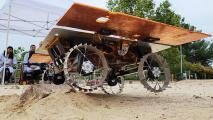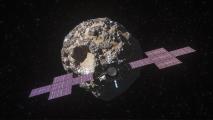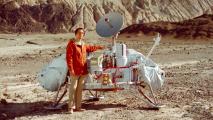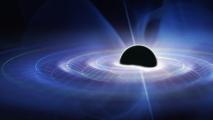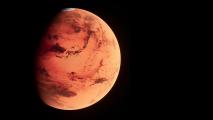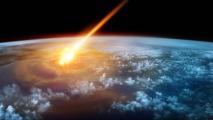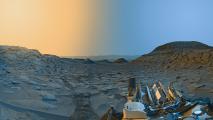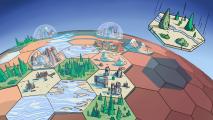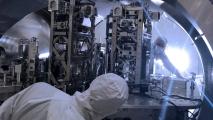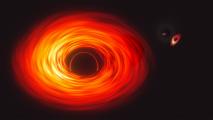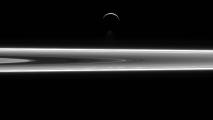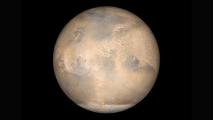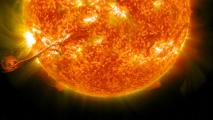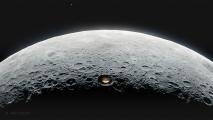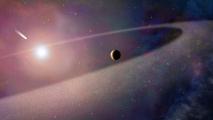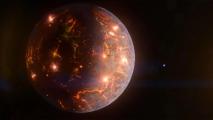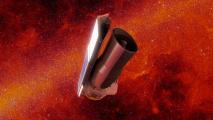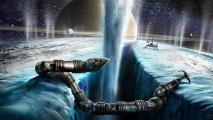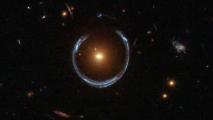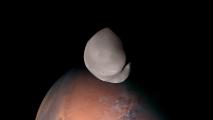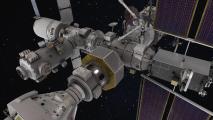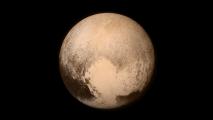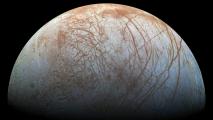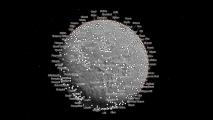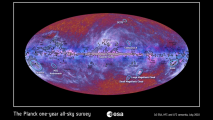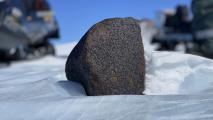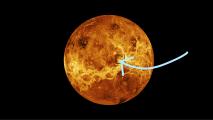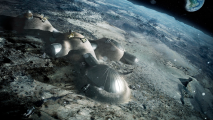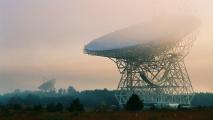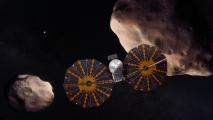Field: Astronomy
T-Minus: Counting down 10 upcoming moon missions
A countdown of 10 upcoming moon missions, all leading up to the one expected to return NASA astronauts to the lunar surface.
T-Minus: How to not die on (the way to) Mars
A breakdown of the five biggest threats to future Mars astronauts and what NASA scientists are doing to overcome each one.
Life on Mars, together
Researchers spent two weeks at the Mars Desert Research Station conducting an analog mission for potential future trips to Mars.
T-Minus: New SpaceX fashion, a Mars mystery, and more
Freethink counts down the biggest space news, featuring new spacesuits, a mission to the dark side of the moon, and more.
Boeing’s Starliner spacecraft was set to launch on May 6 — but was delayed again
Boeing’s Starliner launch – delayed again – will be an important milestone for commercial spaceflight if it can manage to launch.
T-Minus: Psyche phones home, NASA sets sail, and more
Freethink counts down the biggest space news, featuring a new kind of space communication, lots of orbital debris, and more.
T-Minus: $11B Mars rocks, Voyager 1’s resurrection, and more
Freethink counts down the biggest space news, featuring NASA's Mars rock request, the Dragonfly mission, and more.
T-Minus: SpaceX’s military launch, a rocket family’s final flight, and more
Freethink counts down the biggest space news, featuring a new kind of military satellite, the solar eclipse, and more.
Persistent “hiccups” in a far-off galaxy draw astronomers to new black hole behavior
Scientists have found a large black hole that “hiccups,” giving off plumes of gas, revealing another black hole.
How three laser-shooting spacecraft could reveal the birth of the universe
The first space-based mission to detect gravitational waves, LISA, could give us a brand new perspective into the universe’s past.
T-Minus: Counting down the 10 biggest “firsts” in space exploration
A special edition of Freethink's weekly countdown of space news, featuring the 10 biggest milestones in humanity's exploration of space.
T-Minus: Starship reaches new heights, volunteers discover “active” asteroids, and more
Freethink counts down the biggest space news, featuring Starship's third test flight, a new Mars volcano, and more.
T-Minus: A new rocket explodes, China looks to Mars, and more
Freethink's weekly countdown of the biggest space news, featuring Space One's flight failure, China's plans to collect rocks on Mars, & more.
T-Minus: An exploding asteroid, Odie’s final transmission, and more
Freethink's weekly countdown of the biggest space news, featuring a new DART simulation, the end of Odysseus, and more.
T-Minus: An extended asteroid mission, a high-stress moon landing, and more
Freethink's weekly countdown of the biggest space news, featuring SLIM's reawakening, a historic moon landing, and more.
T-Minus: Water discovered on asteroids, first space factory comes home, and more
Freethink's weekly countdown of the biggest space news, featuring the return of Varda's space factory, a Russian space weapon, and more.
Astronomers spot 18 black holes gobbling up nearby stars
Scientists have identified 18 new tidal disruption events (TDEs) — when a nearby star is tidally drawn into a black hole and ripped apart.
T-Minus: SpaceX launches PACE, new ocean moon discovered, and more
Freethink's weekly countdown of the biggest space news, featuring the launch of PACE, the discovery of Mimas' ocean, and more.
What was it like when supermassive black holes arose?
At the center of nearly every massive galaxy is a supermassive black hole ranging from millions to tens of billions of solar masses.
T-Minus: The Mars helicopter’s final flight, a moon lander’s reawakening, and more
Freethink's weekly countdown of the biggest space news, featuring Ingenuity's final flight on Mars, SLIM's revival, and more.
Researchers release open-source space debris model
The MIT Orbital Capacity Assessment Tool lets users model the long-term future space environment to map space debris.
T-Minus: NASA cracks asteroid capsule, Japan joins exclusive moon club, and more
Freethink's weekly countdown of the biggest space news, featuring Japan's moon landing, NASA's asteroid sample, and more.
Ice plumes could reveal signs of life on Europa and Enceladus
A new study shows how we could study the icy plumes of Europa and Enceladus without damaging any complex organic molecules in the process.
T-Minus: SpaceX’s direct-to-cell satellites, XRISM’s first images, and more
Freethink's weekly countdown of the biggest space news, featuring SpaceX's direct-to-cell satellite launch, XRISM's first images, and more.
The 21 most exciting space missions of 2024
2024 is expected to deliver huge wins for the space industry, including 10 moon missions, more Starship launches, and a historic sun swoop.
Google’s quantum computer suggests that wormholes are real
Until recently, wormholes were considered a mathematical curiosity, but Google's quantum computer suggests that wormholes might be real.
T-Minus: SpaceX’s spaceplane launch, Jupiter’s “pizza moon,” and more
Freethink's weekly countdown of the biggest space news, featuring SpaceX's spaceplane launch, a new image of Io, and more.
Scientists rule out a popular alternative theory to dark matter
A passionate minority deny the existence of dark matter and embrace MOND (Modified Newtonian Dynamics) to explain the observations.
“Singularities don’t exist,” claims black hole pioneer Roy Kerr
Using a powerful mathematical argument, black hole expert Roy Kerr argues that singularities shouldn't physically exist. He may be right.
T-Minus: Counting down the 10 greatest space stories of 2023
Freethink's countdown of the biggest space news of 2023, featuring major rocket launches, groundbreaking astronomy discoveries, and more.
T-Minus: Missing space tomato found, a stellar remnant revealed, and more
Freethink's weekly countdown of the biggest space news, featuring NASA's missing space tomato, Webb's new stellar remnant image, and more.
T-Minus: A river of stars, NASA’s next moon landing, and more
Freethink's weekly countdown of the biggest space news, featuring a newly discovered stellar stream, NASA's next moon mission, and more.
NASA’s Webb telescope finds methane in far-off “warm Jupiter”
Astronomers have spotted methane — a molecule linked to the presence of life — in the atmosphere of a “warm Jupiter” exoplanet.
T-Minus: Starship’s big flight, an alien-hunter’s gift, and more
Freethink's weekly countdown of the biggest space news, featuring Starship's second test flight, a new "dark mysteries" telescope, and more.
Is the Universe infinite?
The limits to which we can observe the Universe are set by three things: the rate of expansion, the time since the Big Bang, and the speed of light.
T-Minus: NASA’s surprise asteroid, China’s reusable rocket, and more
Freethink's weekly countdown of the biggest space news, featuring a surprising asteroid discovery, a new reusable rocket, and more.
T-Minus: Stranded space drugs, a new moon lander, and more
Freethink's weekly countdown of the biggest space news, featuring a stranded space factory, Jeff Bezos' new moon lander, and more.
NASA spends $50K on liquid metal spacesuit material
NASA-backed engineers are developing a new spacesuit material that will use liquid metals to repel lunar dust on demand.
Elon Musk’s Starlink satellites are “leaking” signals
Starlink satellites are emitting signals that interfere with our most sensitive radio telescopes, interfering with radio astronomy.
NASA funds AI lasers to zap space junk
NASA is funding the development of AI space lasers to protect its spacecraft and astronauts from potentially deadly space junk.
T-Minus: SpaceX’s wild pace, a marsquake mystery solved, and more
Freethink's weekly countdown of the biggest space news, featuring SpaceX's launch problem, a marsquake mystery, and more.
The 2023 annular eclipse will have huge consequences 6 months later
Only twice a year are the conditions right for the Sun, Earth, and Moon to align in space: creating conditions for either solar or lunar eclipses.
There’s an entire solar system hiding inside Sweden
The Avicii Arena in Stockholm is the world’s largest spherical building and the center of the world’s largest scale model of our solar system.
T-Minus Weekly: Psyche launches, NASA unveils asteroid samples, and more
Freethink's weekly countdown of the biggest space news, featuring the launch of the Psyche, the reveal of NASA's asteroid samples, and more.
Baby star reveals new phase of planet formation for the first time
Astronomers have discovered a newborn star on the brink of planet formation, revealing a part of the process we’ve never seen before.
NASA’s Psyche mission is on its way to a metal asteroid
NASA has successfully launched its Psyche mission, sending a spacecraft on a 2.5-billion-mile journey to a metal-rich asteroid.
T-Minus Weekly: A first for Europe, Musk’s Starship update, and more
Freethink's weekly countdown of the biggest developments in space, featuring a first for Europe, Musk’s Starship update, and more.
Chandrayaan-3’s measurements of sulfur open the doors for lunar science and exploration
Data from Chandrayaan-3’s rover showed the lunar soil contained the expected metal elements, but also an unexpected surprise – sulfur.
NASA’s asteroid sample contains an abundance of carbon and water
On October 11, NASA shared its first update on the Bennu asteroid sample brought to Earth by the OSIRIS-REx mission.
T-Minus Weekly: An astronaut’s return, a Martian dust devil, and more
Freethink's weekly countdown of the biggest developments in space, featuring the return of NASA's Frank Rubio, a dust devil on Mars, and more.
“Forbidden planet” is orbiting a star that should have destroyed it
About 520 light-years from Earth, the planet Halla is orbiting a red giant that should have already engulfed and destroyed it.
Webb telescope spots strange objects in the Orion Nebula
New James Webb Space Telescope images of the Orion Nebula include more than 100 strange objects that are neither planets nor stars.
T-Minus Weekly: NASA’s first asteroid sample, Stoke’s big hop, and more
Freethink's weekly countdown of the biggest developments in space, featuring NASA's first asteroid sample, a Curiosity milestone, and more.
Why astronomers are excited about carbon dioxide and methane in the atmosphere of an alien world
Scientists reported chemical traces in the atmosphere of planet K2-18b, including a substance which on Earth is only produced by living things.
NASA has retrieved its first asteroid sample
NASA has just retrieved its first asteroid sample, bringing nearly 9 ounces of the asteroid Bennu to Earth.
Spending time in space can harm the human body − but scientists are working to mitigate these risks before we go to Mars
With NASA planning more missions to space in the future, scientists are studying how to mitigate health hazards that come with space flight.
Astronomers spot the first “bounce” in our Universe
Imprinted in the structure of the universe are "bouncing" signals from early on: where gravitating normal matter was pushed out by radiation.
Evidence suggests the world’s largest known asteroid impact structure is buried deep in southeast Australia
After years of asteroid impact research, experts think the world’s largest known impact structure is buried deep in the earth in Australia.
T-Minus Weekly: Victus Nox, a record-breaking ISS mission, and more
Freethink's weekly countdown of the biggest developments in space, featuring the launch of Victus Nox, a record-breaking mission, and more.
T-Minus Weekly: The end of O2 on Mars and the week’s other big space stories
Freethink's weekly countdown of the biggest developments in space, featuring the launch of XRISM, the end of MOXIE, and more.
NASA finishes the first experiment to make oxygen on Mars
NASA has officially wrapped up the Mars Oxygen ISRU Experiment (MOXIE), which was the first tech to generate oxygen on Mars.
NASA’s next-gen X-ray observatory is ready for launch (Updated)
XRISM is a next-gen X-ray observatory expected to revolutionize our understanding of the universe’s more energetic objects.
New moon map reveals structures hidden beneath the lunar surface
A new moon map that reveals structures hidden deep beneath the lunar surface also helps unravel the mystery of the moon’s past.
India makes history by landing on the lunar south pole
India is the first nation to soft land on the lunar south pole, an elusive region thought to harbor water ice.
NASA is sending a team of autonomous robots to the moon
NASA is sending three autonomous mobile robots to the moon where they’ll have to work as a team under challenging conditions.
NASA mission to a $10,000-quadrillion asteroid is two months from launch
NASA hopes to get a glimpse at Earth's core by sending a spacecraft to 16 Psyche, an metal-rich asteroid 280 million miles away.
NASA may have accidentally killed the only life we ever found on Mars 50 years ago
Life may have been discovered on Mars almost 50 years ago, but it could have been unintentionally destroyed.
World’s oldest trees reveal the largest solar storm in history
One of the greatest threats to all our infrastructure is a solar storm, which has the potential to cause a multi-trillion dollar disaster.
Astronomers use dead stars to measure gravitational waves produced by ancient black holes
As research challenges theories of how galaxies evolved, studying the era after the Big Bang using gravitational waves could be invaluable.
How Mars lost its magnetic field — and then its oceans
Were it not for Earth's strong magnetic field, our planet would look just like Mars. And strong magnetic fields may be rare in the Universe.
A comet impact 13,000 years ago might have wiped out megafauna
Researchers note a "synchronicity" of geochemical signals suggesting that fragments of a comet struck Earth approximately 13,000 years ago.
NASA shares colorful “postcard” of Mars’ surface
NASA has used photos taken by the Curiosity rover to create a gorgeous “postcard” of the Martian landscape.
Can “terraforming” turn Mars or the moon into Earth 2.0?
Terraforming — the hypothetical process of making another place “Earth-like” — offers the hope of turning Mars or the moon into Earth 2.0.
How the world’s most sensitive yardstick reveals secrets of the universe
When two massive objects – like black holes or neutron stars – merge, they warp space and time. Here's the tool that measures the resulting waves.
New NASA video shows just how big black holes really are
A new NASA animation puts the size of 10 supermassive black holes into perspective by comparing them to our solar system.
NASA spots an enormous water plume erupting on Saturn’s ocean moon
Using the James Webb Space Telescope, researchers are gaining new insights into Enceladus, which holds a sea beneath its icy surface.
How to terraform Mars, without nukes, on a budget
Terraforming Mars has been a dream for decades; here’s how we might get it started today.
Understanding just how big solar flares can get
Recasting the iconic Carrington Event as just one of many superstorms in Earth’s past, scientists reveal the potential for even more massive eruptions.
A massive moon telescope could solve the mystery of the “Cosmic Dark Ages”
NASA hopes a massive radio telescope on the moon will be able to reveal what was happening during the mysterious “Cosmic Dark Ages."
For the first time, astronomers have detected a radio signal from the massive explosion of a dying white dwarf
Patience and persistence pays off in ways researchers never expected, allowing them to hear the dying whispers of a distant star.
Astronomers find Earth-sized planet covered in volcanoes
An Earth-sized exoplanet 90 light years away may be covered in active volcanoes — and home to extraterrestrial life.
NASA’s last “Great Observatory” could be coming out of retirement
A startup’s audacious plan to revive NASA’s retired Spitzer Space Telescope just secured a $250,000 Space Force contract.
Watch NASA’s one-of-a-kind snake robot training to go to space
NASA has released a video of its one-of-a-kind snake robot EELS slithering across a variety of challenging terrains.
See Mars’ mysterious moon Deimos from just 68 miles away
The UAE’s high-resolution images of Mars’ moon Deimos suggest that the tiny satellite isn’t what we thought it was.
NASA’s next space station will be 1,000 times farther from Earth
While NASA prepares to launch its lunar space station, other groups are working to ensure we still have an off-world home closer to Earth.
Astronomers have directly detected a massive exoplanet. The method could transform the search for life beyond Earth.
There are many techniques to search for planets orbiting other stars. Perhaps the simplest of these is called direct imaging, but it's not easy.
NASA’s Habitable Worlds Observatory to finally answer the epic question: “Are we alone?”
The Nancy Roman Telescope is already being built with a goal no smaller than to find inhabited planets beyond Earth.
Jupiter’s moons hide giant subsurface oceans
Three of Jupiter’s moons – Europa, Ganymede and Callisto – are home to large, underground oceans of liquid water that could support life.
New method could triple the size of space telescope mirrors
A new technique for making super-thin, lightweight space telescope mirrors could dramatically improve our view of space.
You can now explore the highest-res map of Mars ever made
Caltech researchers have created an interactive map of Mars that lets anyone explore the surface of the Red Planet in unprecedented detail.
Space could be a trillion dollar industry by 2040
Now that falling launch costs are making space more accessible, hundreds of groups are looking for ways to make money off-world.
Why Earth is the only planet with plate tectonics
Here in our Solar System, of all the known planets, only Earth — not Mercury, not Venus, and not Mars — possesses plate tectonics.
The strongest evidence for a Universe before the Big Bang
For many decades, people conflated the hot Big Bang, describing the early Universe, with a singularity: that this "Big Bang" was the birth of space and time.
How Einstein tried to model the shape of the Universe
Two years after proposing his general theory of relativity, Einstein endeavored to find the shape of the Universe.
“Treasure map” guides scientists to massive meteorite
A “treasure map” highlighting places where meteorites are most likely to be found has led to the discovery of a 17-pound space rock.
Venus may have currently active volcanoes
Old images from NASA’s Magellan mission may have revealed that Venus, a close analogue to Earth, has volcanic activity.
Terraforming: why the Moon is a better target than Mars
While most of humanity's terraforming dreams have focused on Mars, a better candidate may be even closer: the Moon.
Undergrad develops AI to hunt for alien signals
An AI trained to hunt for technosignatures from intelligent alien life found 8 interesting signals on its first deployment.
NASA’s “Lucy” will take a 40,000-mile detour to visit this asteroid
NASA has added a tenth asteroid flyby to the record-breaking Lucy mission so that it can test a new asteroid-tracking system.

